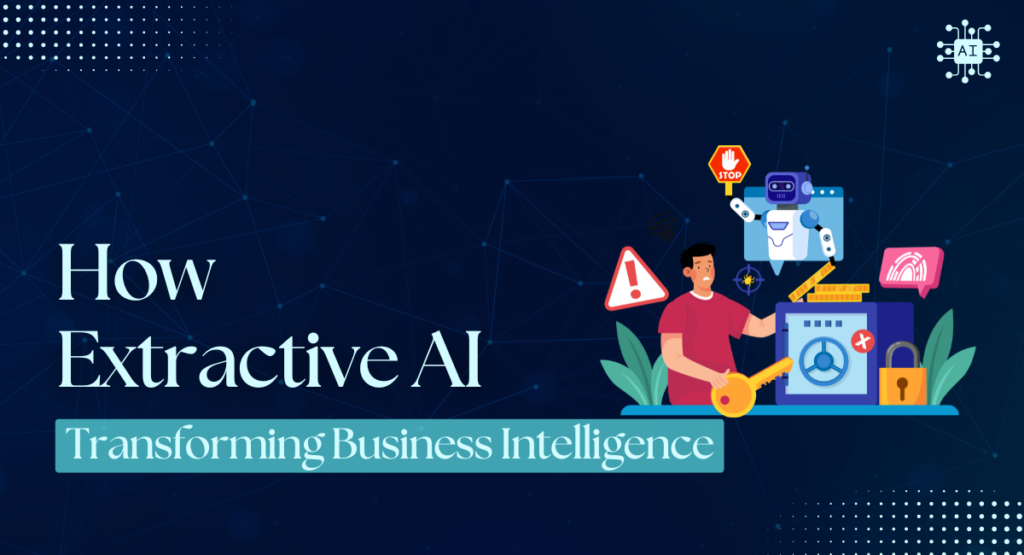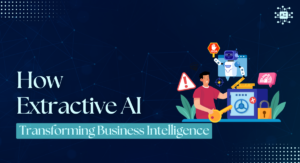Businesses today deal with large amounts of data every day, but finding the correct information quickly is still a significant challenge.
For a long time, business intelligence (BI) systems have helped companies understand and analyze structured data like sales figures or customer metrics.
Extractive AI is changing that.
AI allows businesses to pull helpful information directly from various data sources without time-consuming manual work.
This technology helps companies gather the needed insights, making faster and more accurate decisions.
Whether a company is trying to improve customer service or analyze detailed reports, extractive AI is now a crucial part of how modern businesses handle information.
What is Extractive AI?
Extractive AI is a type of artificial intelligence that focuses on pulling out specific pieces of information from large sets of data.
Unlike other types of AI that might generate new content, the future of extractive AI helps find and extract valuable data from sources like documents, emails, or reports.
Key points:
- Extractive AI pulls relevant data from large sources.
- It focuses on finding existing information, not generating new content.
- Useful for analyzing both structured and unstructured data.
- Saves businesses time by automating data extraction.
- Common in tasks like text summarization, data mining, and keyword identification.
The Role of Extractive AI in Business Intelligence
Here are the critical points for The Role of Extractive AI in Business Intelligence in bullet format:
- Extractive AI helps businesses handle unstructured data, like emails, social media posts, and customer feedback.
- It allows companies to gather insights quickly without manual data processing.
- Extractive AI improves the efficiency and accuracy of business intelligence by identifying relevant information from vast data sources.
- It works alongside traditional BI systems to provide more detailed insights from text-heavy, unstructured data.
- Typical tasks include summarizing reports, analyzing customer sentiment, and extracting critical themes from large documents.
Example: A retail company tracks customer reviews from various online platforms. Instead of manually reading through thousands of comments, the company uses extractive AI to pull out key trends, such as common complaints about product quality or frequent praise for delivery speed.
This enables the company to address specific issues and improve customer satisfaction more efficiently.
How Extractive AI Transforms Data-Driven Decision Making
Here’s an informative and easy-to-understand.
- Extractive AI helps businesses make decisions faster by quickly pulling out valuable data from large amounts of information.
- Businesses use extractive AI to find specific data points they need instead of manually going through reports, emails, or customer reviews, saving time.
- It provides real-time insights, allowing businesses to act quickly on changing situations or trends.
- Extractive AI helps businesses make better decisions by providing accurate and relevant data, reducing the chances of missing critical information.
- It uses natural language processing (NLP) to understand and interpret text data, making it easier for businesses to analyze customer feedback, reviews, or social media comments.
Example: Imagine a company that receives thousands of customer emails each day. Instead of reading each email, extractive AI can analyze the text and pull out common issues or requests.
If many customers are reporting similar problems with a product, the company can quickly identify the issue and take action to fix it. This speeds up decision-making and improves customer satisfaction and improves customer satisfaction.
Benefits of Using Extractive AI in Business Intelligence
Adopting extractive AI in business intelligence provides many significant benefits, especially when handling large-scale data.
- Speed and Efficiency: One of the most apparent benefits is the speed at which extractive AI can process vast amounts of information. What might take a human weeks to compile and analyze, AI can do in minutes, freeing up employees for more strategic work.
- Accuracy: Extractive AI reduces the risk of human error, especially when dealing with enormous datasets. AI systems don’t get tired or make mistakes due to fatigue, ensuring consistent data retrieval and analysis accuracy.
- Better Insights from Unstructured Data: Traditional BI tools are excellent for structured data but struggle with the vast amounts of unstructured information. Extractive AI bridges this gap, allowing companies to extract actionable insights from emails, social media posts, documents, etc.
- Enhanced Productivity: Businesses can operate more efficiently by automating data extraction and analysis. Employees are freed from tedious data-gathering tasks and can focus on high-level decision-making and creative problem-solving.
- Faster Decision Cycles: In today’s fast-paced business world, timely decisions are critical. With extractive AI, businesses can quickly analyze relevant data, allowing them to respond to challenges and opportunities faster.
Personalized Customer Insights: By using extractive AI, businesses can better understand customer preferences and behaviors. This leads to more personalized marketing efforts, better product recommendations, and enhanced customer experiences.
Challenges and Limitations of Extractive AI
Despite its many advantages, extractive AI comes with some challenges.
Over-reliance on AI: While AI can be mighty, it should not completely replace human judgment. Businesses can always risk relying too heavily on AI-generated insights without considering other critical factors that only humans can interpret.
Data Quality: The effectiveness of extractive AI depends on the data quality it processes. If the input data is incomplete or incorrect, the insights generated will be flawed. Companies must ensure they feed clean, relevant data into their AI systems.
Bias in Data Extraction: AI algorithms can inadvertently carry biases from the data they are trained on. If the data reflects biased patterns or inaccurate representations, the AI may perpetuate these biases, negatively affecting decision-making.
Ethical Concerns: Automated data extraction can sometimes lead to ethical concerns regarding privacy. Businesses must comply with data privacy regulations and ethical standards when using AI for data extraction.
Future Trends: Extractive AI and Business Intelligence
Example: Bloomberg uses extractive AI to analyze vast amounts of financial data, news, and reports. The AI pulls out key real-time metrics and insights, helping traders and analysts make fast, informed decisions. This automation saves time and ensures accuracy in financial data.
Future Scope:
- Deeper Data Integration: AI will handle multimedia content like videos and images for more comprehensive insights.
- Personalized Insights: AI will deliver tailored data summaries specific to each business’s needs.
- AI-Powered Assistants: Real-time data summaries during meetings will aid quick decision-making.
- Wider Industry Use: Extractive AI will expand into healthcare, legal, and manufacturing, providing better insights from complex data sources.
Conclusion
Extractive AI is revolutionizing the way businesses handle and interpret data. By enabling faster, more accurate data extraction, AI is helping companies to make more informed decisions, improve customer experiences, and stay ahead of the competition.
As AI technology continues to evolve, the role of extractive AI in business intelligence will only become more crucial. It will help businesses stay agile and responsive in an increasingly data-driven world.


